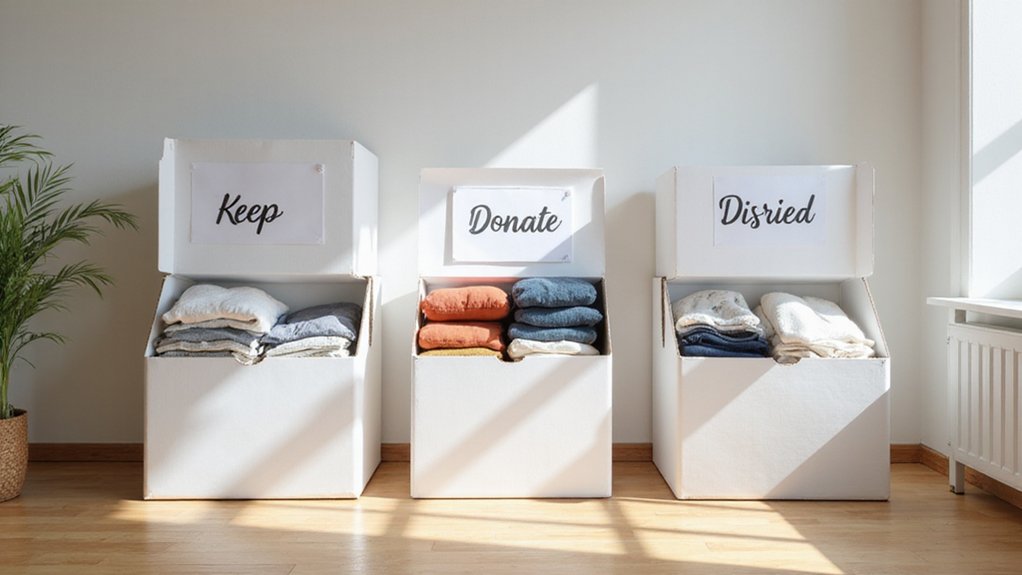Moving can feel overwhelming, but decluttering is your secret weapon for a smoother progression. You'll lighten your load, reduce stress, and potentially save money on moving costs. By systematically sorting through your belongings, you'll create space—both physically and mentally—for your next chapter. Want to know how to transform this potentially daunting task into an empowering expedition of simplification?
Key Takeaways
- Conduct a systematic room-by-room evaluation, sorting items into clear categories of keep, donate, sell, and discard based on current utility and practical value.
- Apply the one-year rule: If you haven't used an item in the past 12 months, strongly consider removing it from your collection.
- Prioritize emotional well-being by photographing sentimental items you cannot keep, preserving memories without maintaining physical clutter that constrains your mobility.
- Leverage professional moving services to help objectively assess possessions and provide emotional support during the challenging downsizing process.
- Create designated sorting zones with clear containers or spaces for keep, donate, and discard items to maintain organization and decision momentum.
Understanding the Psychology of Decluttering
Decluttering before a move isn't just about sorting through physical items; it's a deeply emotional process that challenges our attachment to possessions. You'll likely encounter decision paralysis as memories flood back, making it tough to let go. Each object carries a story, and parting with them can feel like losing a piece of your past.
But remember, you're not erasing memories—you're making space for new experiences. Recognize that emotional attachment doesn't mean keeping everything. By understanding the psychological barriers, you'll find the courage to release what no longer serves you, creating freedom for your next chapter. Senior moving services can provide professional assistance in navigating the complex emotional and logistical challenges of downsizing and decluttering.
Essential Sorting Categories and Decision Framework
Once you've acknowledged the emotional weight of your possessions, organizing your belongings becomes a strategic process of systematic sorting.
Your decluttering (structure/blueprint/model) should include clear decision factors: keep, donate, sell, and discard. Evaluate each item's practical value, emotional significance, and future utility. Ask yourself: Have I used this in the past year? Does it serve a current purpose? Will it fit in my new space?
Be ruthless yet compassionate with your choices, understanding that letting go doesn't diminish memories but creates space for new experiences and opportunities. When moving apartments, consider that professional moving services can help streamline the process of sorting and relocating your most cherished belongings.
Room-by-Room Decluttering Strategy
When tackling a move, breaking down your decluttering process room by room can convert an overwhelming task into a manageable strategy. Your room-by-room approach should include:
- Quick inspection process in each space
- Creating designated decluttering zones
- Sorting items into clear categories
- Making immediate decisions about possessions
Start with smaller rooms like bathrooms and home offices, which tend to accumulate unnecessary items quickly. Use a systematic method, moving methodically through drawers, closets, and shelves.
Handling Sentimental and High-Value Items
As you progress through your moving preparation, some items will require more thoughtful consideration than simply sorting into "keep" or "discard" piles. Prioritizing sentimental value means evaluating each treasured possession carefully.
Family heirlooms, photographs, and meaningful gifts deserve special attention. For high-value collectibles, consider professional appraisal to understand their true worth. You might choose to photograph sentimental items you can't keep, preserving memories without storing physical objects.
When deciding, ask yourself if the item genuinely brings joy or if you're holding onto it out of obligation. Your goal is freedom from unnecessary attachments.
Digital Decluttering and Document Management
In today's technological era, managing your electronic files and documents is just as essential as organizing physical belongings during a relocation. Digital decluttering helps you streamline your life and reduce unnecessary digital paper trail stress.
Consider these key strategies for digital organization:
- Consolidate cloud storage solutions
- Delete redundant files and emails
- Back up important documents securely
- Organize digital files into clear folders
Simplifying your digital milieu means less mental clutter and more freedom. By proactively managing your electronic documents, you'll create a more seamless shift during your move and feel more in control of your digital life.
Donation and Disposal Best Practices
Just like you've organized your digital files, sorting through physical items for donation or disposal requires strategic planning. Research local charity organization partnerships to maximize the impact of your unwanted items.
Schedule donation pick up services to simplify the process and save time during your move. Consider the condition of your belongings and prioritize donating items that are still in good shape.
For items that can't be donated, check local recycling guidelines or waste disposal regulations to guarantee you're disposing of things responsibly and ethically.
Selling Unwanted Items for Extra Cash
Increase your moving budget by clearing out unwanted items through strategic selling strategies. You'll want to maximize your profits and lighten your moving load simultaneously.
4 powerful selling approaches:
- Utilize online selling platforms like Facebook Marketplace and Craigslist
- Host a well-organized yard sale targeting neighborhood buyers
- Use specialty apps for specific item categories (clothing, electronics)
- Consider consignment shops for high-value furniture and designer pieces
These methods convert clutter into cash, giving you financial flexibility and a simplified moving experience. By selling smartly, you're not just disposing of items—you're creating opportunity and freedom.
Packing and Moving Efficiently After Decluttering
Efficiency becomes your greatest ally after decluttering, optimizing a potentially stressful move into a simplified process. You'll want to harness packing hacks and create detailed moving checklists that expedite your relocation.
Start by gathering quality moving boxes and packing supplies in advance. Organize your items systematically, labeling each box with its contents and destination room. Pack room by room, keeping essential items easily accessible. Consider using color-coded labels or a numbering system to track your belongings.
Your strategic approach will reduce moving day chaos and help you feel more in control of this significant life shift.
Frequently Asked Questions
How Long Does the Entire Decluttering Process Typically Take?
You'll need 1-3 weeks for a realistic decluttering timeline, depending on your home's size. Don't rush; break the multistage process into manageable chunks to feel liberated from excess belongings.
What if I'm Emotionally Attached to Most of My Belongings?
You'll struggle with letting go, but practice mindfulness techniques to detach from objects. Consider professional decluttering assistance to help you objectively evaluate emotional connections and liberate yourself from unnecessary possessions.
Can I Declutter Effectively if I'm Short on Time?
You'll crush decluttering with time-saving strategies and a minimalist mindset. Focus on high-impact areas, set quick sorting timers, and trust your gut about what truly matters in your expedition to liberation.
What Should I Do With Items of Uncertain Sentimental Value?
You'll want to assess true sentimental value by asking if the item sparks genuine emotion or memories. Prioritize meaningful items that truly represent your life path, liberating yourself from unnecessary emotional baggage.
How Can I Prevent Future Clutter After This Move?
You'll want to implement storage strategies that limit incoming items and establish routine decluttering habits. Commit to periodic assessments, resist impulse purchases, and create systems that help you maintain a clutter-free living space.



